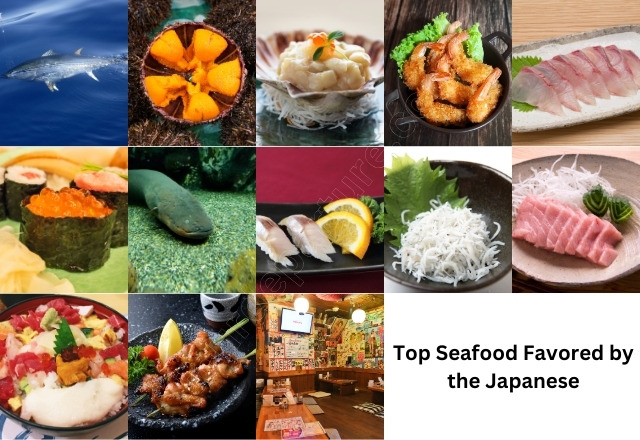Japan is an island country and the people of this country have always respected and relied on the sea for their livelihood. It would therefore not be a surprise that seafood is commonly used in Japanese foods and recipes. However, there is more to seafood than the canned tuna and the salmon found on sushi establishment’s menus. Let’s dive into some of the most beloved seafood enjoyed in Japan
- The King of Fishes: Blue Fin Tuna – Known for its high-fat content, the fish is a preferred meat for sushi and sashimi with specific mention of chutoro or the medium-fatty belly of the fish. Japanese have adopted a very elaborate grading system for tuna so as to make sure the best is provided for consumption.
- Sea Urchin (Uni) – Uni has a pearly, ocean-like taste and soft mouthfeel, which is not everyone’s cup of tea. However, for the Japanese it is more than just a dish but rather considered a delicacy. Fresh uni is commonly eaten plain so that it retains its sweetness.
- Hotate (Scallops) – Hotate is slightly sweet and is firm and tender in texture, making scallops a favorite choice. Delightful when eaten uncooked in sushis, fried on an iron plate or even stewed in clear soup, hotate never lacks variety.
- Ebi (Shrimp) – In Japan, Ebi has different types, such as amaebi, sweet shrimp, and kurumaebi, tiger shrimp. Ebi is commonly consumed raw with sushi, grilled with flavorful heads, or Tempura-style, giving it a crispy texture.
- Kanpachi (Yellowtail) – Being a popular sushi and sashimi fish, Kanpachi is characterized by its yellow color and firm taste. It is also enjoyed pan-fried or barbecued and the skin becomes crispy when properly prepared.
- Ikura (Salmon Roe) – These shiny orange spheres of ikura provide a tangy fishy taste to the sushi bowls and other dishes. It is also popularly consumed with rice and due to its bright green color, it would naturally complement any dish beautifully.
- Freshwater Eel – Grilled and coated with a sweet and savory sauce, Unagi is one of the most famous comfort food items originating from Japan. Unagi donburi which is grilled eel on rice is taken at lunch or dinner.
When it comes to seafood, Japan’s choices are far from conventional. Here are some lesser-known but equally delicious options to tantalize your taste buds
- Saba (Mackerel) – Saba, with its strong, fatty flavor, is usually broiled or seasoned and eaten with grated daikon radish to offset the oils. Saba is, however, more well-known during the winter months.
- Shirasu (Whitebait) -These are small transparent fish, taken in spring, and can be eaten raw with rice and vinegar or boiled in water.
- Toro (Toro Tuna) – The belly of the tuna, toro is the ultimate luxury for sushi lovers. The melt-in-your-mouth texture and bursting with flavor make it so sinful.
- Kaisen-don (Seafood Bowl) – This is a delicious bowl of Japanese rice topped with a variety of fresh seafood including seasonal fish and shellfish.
- Yakitori – Not just chicken! Seafood yakitori is primarily available at yakitori stalls and includes skewered scallops, squid, salmon and tuna bellies.
- Izakaya Favorites: Izakaya pubs in Japan are active centers for the consumption of seafood snacks. A few examples are grilled oysters, simmered clams, and fried soft-shell crab.
Seasonality and Technique
Seasonality is a feature that characterizes Japanese cuisine probably more than any other cuisine in the world. Seafood is no exception. There are certain fishes that are in season throughout the year and the Japanese master chefs make use of this and prepare fish dishes that would enhance the flavor and texture of the fish.
The other major consideration is the focus on quality work. As for preparation, teppanyaki dishes are cooked in a style where Japanese techniques show the natural goodness of the seafood without overpowering the dish.
With its focus on freshness, seasonality, and expert preparation, Japan offers an amazing seafood experience for any adventurous eater. So, next time you’re craving Japanese cuisine, embark on a culinary adventure and enjoy the delicious bounty of the Japanese seas!
You might also consider exploring beyond the restaurant scene. Japan’s busy fish markets, like the famous Tsukiji Outer Market in Tokyo, offer a chance to see the strong connection between the Japanese people and the sea. Watching the incredible variety of fresh catches, the lively vendors, and the careful selection process adds a new level of appreciation for the excellent seafood on Japanese tables. Dive into the world of Japanese seafood and discover flavors and culinary artistry that will leave you wanting more.

